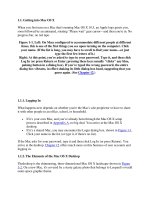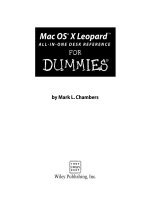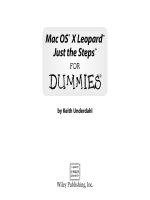OReilly learning UNIX for mac OS x panther dec 2003 ISBN 0596006179
Bạn đang xem bản rút gọn của tài liệu. Xem và tải ngay bản đầy đủ của tài liệu tại đây (3.11 MB, 297 trang )
•
•
•
•
•
•
TableofContents
Index
Reviews
ReaderReviews
Errata
Academic
LearningUnixforMacOSXPanther
ByBrianJepson,DaveTaylor
Publisher :O'Reilly
PubDate :December2003
ISBN :0-596-00617-9
Pages :184
Thiscompactbookprovidesauser-friendly
tourfortheuninitiatedoftheMacUnixbase.
YoucansafelyexploreTerminaland
familiarizeyourselfwiththecommandline,
learningasyougoaboutthehundredsof
UnixprogramsthatcomewithyourMac.
You'llbegintounderstandthepowerand
flexibilityofUnix.AndifUnixisn'tnewto
you,you'lldiscoverhowittranslatesintothis
latestMacincarnation.UpdatedtocoverMac
OSXPanther(MacOSX10.3),thisbookwill
keepyoucurrentwiththelatestfeaturesof
yourMac.
•
•
•
•
•
•
TableofContents
Index
Reviews
ReaderReviews
Errata
Academic
LearningUnixforMacOSXPanther
ByBrianJepson,DaveTaylor
Publisher :O'Reilly
PubDate :December2003
ISBN :0-596-00617-9
Pages :184
Copyright
Preface
Audience
WhoThisBookIsNotFor
ABriefHistory
InterfacestoUnix
UsingCodeExamples
TheEvolutionofThisBook
VersionsofUnix
ConventionsUsedinThisBook
CommentsandQuestions
AcknowledgmentsforDaveTaylor
AcknowledgmentsforBrianJepson
Chapter1.GettingIntoUnix
Section1.1.WhyUseUnix?
Section1.2.LaunchingTerminal
Section1.3.CustomizingYourShellEnvironment
Section1.4.FurtherCustomization
Chapter2.UsingtheTerminal
Section2.1.WorkingwiththeTerminal
Section2.2.SyntaxofaUnixCommandLine
Section2.3.TypesofCommands
Section2.4.TheUnresponsiveTerminal
Chapter3.UsingUnix
Section3.1.TheMacOSXFilesystem
Section3.2.ProtectingandSharingFiles
Section3.3.SuperuserPrivilegeswithsudo
Section3.4.ExploringExternalVolumes
Chapter4.FileManagement
Section4.1.FileandDirectoryNames
Section4.2.FileandDirectoryWildcards
Section4.3.CreatingandEditingFiles
Section4.5.ManagingFiles
Section4.4.ASimplerviAlternative:Pico
Chapter5.Printing
Section5.1.FormattingandPrintCommands
Section5.2.Non-PostScriptPrinters
Chapter6.RedirectingI/O
Section6.1.StandardInputandStandardOutput
Section6.2.PipesandFilters
Chapter7.Multitasking
Section7.1.RunningaCommandintheBackground
Section7.2.CheckingonaProcess
Section7.3.CancelingaProcess
Chapter8.AccessingtheInternet
Section8.1.RemoteLogins
Section8.2.TransferringFiles
Chapter9.OfWindowsandDownloads
Section9.1.X11
Section9.2.Fink
Section9.3.SomePicks
Chapter10.WheretoGofromHere
Section10.1.Documentation
Section10.2.ShellAliasesandFunctions
Section10.3.Programming
Section10.4.MorePossibilities:PerlandPython
Colophon
Index
[TeamLiB]
[SYMBOL][A][B][C][D][E][F][G][H][I][J][K][L][M][N][O][P][Q][R][S]
[T][U][V][W][X][Y][Z]
[TeamLiB]
Preface
MacOSX(pronounced"MacOSTen"),thelatestincarnationof
theMacintoshoperatingsystem,isaradicaldeparturefrom
previousversions.Notonlyisthereawholenewlookandfeel
onthesurface,therearealsohugedifferencesunderthehood.
Alltheold,familiarMacintoshsystemsoftwarehasbeen
replacedwithanotheroperatingsystem,calledUnix.Unixisa
multiuser,multitaskingoperatingsystem.Beingmultiuser
meansMacOSXallowsmultipleuserstosharethesame
system,eachhavingtheabilitytocustomizetheirdesktop,
createfilesthatcanbekeptprivatefromotherusers,andmake
settingsthatwillautomaticallyberestoredwheneverthat
personusesthecomputer.BeingmultitaskingmeansMacOSX
caneasilyrunmanydifferentapplicationsatthesametime,
andthatifoneapplicationcrashesorhangs,theentiresystem
doesn'tneedtoberebooted.
ThefactthatMacOSXisUnixunderthehooddoesn'tmatterto
userswhosimplywanttouseitsslickgraphicalinterfacetorun
theirapplicationsormanagetheirfiles.Butitopensupworlds
ofpossibilitiesforuserswhowanttodigalittledeeper.The
Unixcommand-lineinterface,whichisaccessiblethroughaMac
applicationintheUtilitiesfoldercalledTerminal,providesan
enormousamountofpowerforintermediateandadvanced
users.What'smore,onceyou'velearnedtouseUnixinMacOS
X,you'llalsobeabletousethecommandlineinotherversions
ofUnixortheUnix-compatibleLinux.
ThisbookisdesignedtoteachthebasicsofUnixtoMacintosh
users.Wetellyouhowtousethecommandline(whichUnix
usersrefertoas"theshell")andthefilesystem,aswellas
someofthemostusefulcommands.Unixisacomplexand
powerfulsystem,sowescratchonlythesurface,butwealso
tellyouhowtodeepenyourUnixknowledgeonceyou'reready
formore.
Copyright
Copyright©2004,2003,2002O'Reilly&Associates,Inc.
PrintedintheUnitedStatesofAmerica.
PublishedbyO'Reilly&Associates,Inc.,1005Gravenstein
HighwayNorth,Sebastopol,CA95472.
O'Reilly&Associatesbooksmaybepurchasedforeducational,
business,orsalespromotionaluse.Onlineeditionsarealso
availableformosttitles().Formore
information,contactourcorporate/institutionalsales
department:(800)998-9938or
NutshellHandbook,theNutshellHandbooklogo,andthe
O'ReillylogoareregisteredtrademarksofO'Reilly&Associates,
Inc.LearningUnixforMacOSXPanther,theimageofan
Alaskanmalamute,andrelatedtradedressaretrademarksof
O'Reilly&Associates,Inc.
Apple,theApplelogo,AppleScript,AppleTalk,AppleWorks,
Cocoa,Finder,Mac,Macintosh,MPW,QuickDraw,QuickTime,
andSherlockaretrademarksofAppleComputer,Inc.,
registeredintheUnitedStatesandothercountries.Aqua,
Carbon,andQuartzaretrademarksofAppleComputer,Inc.
Manyofthedesignationsusedbymanufacturersandsellersto
distinguishtheirproductsareclaimedastrademarks.Where
thosedesignationsappearinthisbook,andO'Reilly&
Associates,Inc.wasawareofatrademarkclaim,the
designationshavebeenprintedincapsorinitialcaps.
Whileeveryprecautionhasbeentakeninthepreparationofthis
book,thepublisherandauthorsassumenoresponsibilityfor
errorsoromissions,orfordamagesresultingfromtheuseof
theinformationcontainedherein.
Audience
Thisbookteachesbasicsystemutilitycommandstogetyou
startedwithUnix.Insteadofoverwhelmingyouwithlotsof
details,wewantyoutobecomfortableintheUnixenvironment
assoonaspossible.Sowecovereachcommand'smostuseful
featuresinsteadofdescribingallitsoptionsindetail.
Wealsoassumethatyourcomputerworksproperly;youhave
startedit,knowtheprocedureforturningthepoweroff,and
knowhowtoperformsystemmaintenance.
WhoThisBookIsNotFor
Ifyou'reseekingabookthattalksabouthowtodevelopCocoa
programsorotherwisebuildMacsoftwareapplications,thisisn't
yourbook(thoughit'squitehelpfulfordeveloperstohavea
goodgraspofMacOSXUnixessentials).Ifyou'reacomplete
beginnerandareoccasionallystymiedbywherethesecond
mousebuttonwent,thismightbeabetterbooktoputonthe
shelfuntilyou'remorecomfortablewithyourcomputing
environment.Finally,ifyouliveandbreatheUnixeverydayand
canmakeyourLinuxboxdobackflips,thisbookwillbetoo
basicforyou(though,sincewecovermanyoftheMacOSX
Unixnuances,you'llstillgleaninformationfromreadingit).We
don'tcovereitherUnixsystemadministrationorMacsystem
administrationfromthecommandline.
ABriefHistory
TheMacintoshstartedoutwithasingle-taskingoperating
systemthatallowedsimpleswitchingbetweenapplications
throughanapplicationcalledtheFinder.Morerecentversionsof
MacOShavesupportedmultipleapplicationsrunning
simultaneously,butitwasn'tuntilthelandmarkreleaseofMac
OSXthattruemultitaskingarrivedintheMacintoshworld.With
MacOSX,Macintoshapplicationsruninseparatememory
areas;theMacisatruemultiusersystemthatalsofinally
includesproperfile-levelsecurity.
Toaccomplishtheseimprovements,MacOSXmadethejump
fromaproprietaryunderlyingoperatingenvironmenttoUnix.
MacOSXisbuiltontopofDarwin,aversionofUnixbasedon
BSD4.4Lite,FreeBSD,NetBSD,andtheMachmicrokernel.
Unixitselfwasinventedmorethan30yearsagoforscientific
andprofessionaluserswhowantedaverypowerfulandflexible
OS.Ithasevolvedsincethenthrougharemarkablycircuitous
path,withstopsatBellTelephoneLabs,UCBerkeley,research
centersinAustraliaandEurope,andtheU.S.Departmentof
DefenseAdvancedResearchProjectsAgency(forfunding).
BecauseUnixwasdesignedforexperts,itcanbeabit
overwhelmingatfirst.Butafteryougetthebasics(fromthis
book!),you'llstarttoappreciatesomeofthereasonstouse
Unix:
Itcomeswithahugenumberofpowerfulapplication
programs.YoucangetmanyothersforfreeontheInternet.
(TheFinkproject,availablefromSourceForge
(bringsmanyopensource
packagestoMacOSX.)Youcanthusdomuchmoreata
muchlowercost.Anotherplacetoexploreisthecool
DarwinPortsproject,whereadedicatedteamofsoftware
developersarecreatingDarwinversionsofmanypopular
Unixapps
( />Notonlyaretheapplicationsoftenfree,butsoaresome
Unix(andUnix-compatible)operatingsystems.Linuxand
FreeBSDaregoodexamples.Likethefreeapplications,
mostfreeUnixversionsareofexcellentquality.They're
maintainedbyvolunteerprogrammersandcorporations
whowantapowerfulOSandarefrustratedbytheslow,
bug-riddenOSdevelopmentatsomebigsoftware
companies.MacOSX'sDarwincoreisafreeUnixOS(getit
atbutitdoesnot
haveMacOSX'seasy-to-useinterface.Manypeopleuse
MacOSXdailywithouteverknowingaboutallthepower
lurkingunderthehood.
Unixrunsonalmostanykindofcomputer,fromtiny
embeddedsystemstogiantsupercomputers.Afteryouread
thisbook,you'llnotonlyknowallaboutDarwin,butyou'll
alsobereadytousemanyotherkindsofUnix-based
computerswithoutlearninganewOSforeachone.
Ingeneral,Unix(especiallywithoutawindowingsystem)is
lessresourceintensivethanothermajoroperatingsystems.
Forinstance,Linuxwillrunhappilyonanoldsystemwith
anIntel80386microprocessorandletmultipleusersshare
thesamecomputer.(Don'tbothertryingtousethelatest
versionsofMicrosoftWindowsonasystemthat'smorethan
afewyearsold!)Ifyouneedawindowingsystem,Unixlets
youchoosefrommodernfeature-richinterfacesaswellas
fromsimpleonesthatneedmuchlesssystempower.
Anyonewithlimitedresourceseducationalinstitutions,
organizationsindevelopingcountries,andsooncanuse
Unixtodomorewithless.
MuchoftheInternet'sdevelopmentwasdoneonUnix
systems.ManyInternetwebsitesandserviceprovidersuse
Unixbecauseit'ssoflexibleandinexpensive.Withpowerful
hardware,Unixreallyshines.
VersionsofUnix
ThereareseveralversionsofUnix.Somepastandpresent
commercialversionsincludeSolaris,AIX,andHP/UX.Freely
availableversionsincludeLinux,NetBSD,OpenBSD,and
FreeBSD.Darwin,thefreeUnixunderneathMacOSX,wasbuilt
bygraftinganadvancedversioncalledMachontoBSD,witha
lightsprinklingofApplemagicforthewindowingsystem.
Althoughgraphicaluserinterfaces(GUIs)andadvanced
featuresdifferamongUnixsystems,youshouldbeabletouse
muchofwhatyoulearnfromthisintroductoryhandbookonany
system.Don'tworrytoomuchaboutwhat'sfromwhatversion
ofUnix.JustasEnglishborrowswordsfromFrench,German,
Japanese,Italian,andevenHebrew,MacOSXUnixborrows
commandsfrommanydifferentversionsofUnix,andyoucan
usethemallwithoutpayingattentiontotheirorigins.
Fromtimetotime,wedoexplainfeaturesofUnixonother
systems.Knowingthedifferencescanhelpyouifyoueverwant
touseanothertypeofUnixsystem.Whenwewrite"Unix"in
thisbook,wemean"Unixanditsversions,"unlesswe
specificallymentionaparticularversion.
InterfacestoUnix
Unixcanbeusedasitwasoriginallydesigned:ontypewriterliketerminals,fromapromptonacommandline.Mostversions
ofUnixalsoworkwithwindowsystems(orGUIs).Theseallow
eachusertohaveasinglescreenwithmultiple
windowsincluding"terminal"windowsthatactliketheoriginal
Unixinterface.
MacOSXincludesasimpleterminalapplicationforaccessing
thecommand-linelevelofthesystem.Thatapplication,
reasonablyenough,iscalledTerminalandcanbefoundinthe
Applications Utilitiesfolder.TheTerminalapplicationwillbe
examinedmorecloselyinChapter1andChapter2.
AlthoughyoucancertainlyuseyourMacquiteefficiently
withouttypingtextatashellprompt,we'llspendallourtimein
thisbookonthattraditionalcommand-lineinterfacetoUnix.
Why?
EveryUnixsystemhasacommand-lineinterface.Ifyou
knowhowtousethecommandline,you'llalwaysbeableto
usethesystem.
IfyoubecomeamoreadvancedUnixuser,you'llfindthat
thecommandlineisactuallymuchmoreflexiblethana
windowinginterface.Unixprogramsaredesignedtobe
usedtogetherfromthecommandlineas"buildingblocks"in
analmostinfinitenumberofcombinations,todoaninfinite
numberoftasks.Nowindowingsystemwe'veseen(yet!)
hasthistremendouspower.
YoucanlaunchandcloseGUIprogramsfromthecommand
line.
Onceyoulearntousethecommandline,youcanusethose
sametechniquestowritescripts.Theselittle(orbig!)
programsautomatejobsyou'dhavetodomanuallyand
repetitivelywithawindowsystem(unlessyouunderstand
howtoprogramawindowsystem,whichisusuallyamuch
harderjob).SeeSection10.3inChapter10forabrief
introductiontoscripting.
Ingeneral,text-basedinterfacesaremucheasierthanGUIs
forsight-impairedusers.
Wearen'tsayingthatthecommand-lineinterfaceisrightfor
everysituation.Forinstance,usingtheWebwithitsgraphics
andlinksisusuallyeasierwithaGUIwebbrowserwithinMac
OSX.Butthecommandlineisthefundamentalwaytouse
Unix.UnderstandingitwillletyouworkonanyUnixsystem,
withorwithoutwindows.AgreatresourceforgeneralMacOSX
information(theGUIyou'reprobablyusedto)canbefoundin
MacOSX:TheMissingManualbyDavidPogue(Pogue
Press/O'Reilly).
ConventionsUsedinThisBook
Thefollowingtypographicalconventionsareusedinthisbook:
Plaintext
Indicatesmenutitles,menuoptions,menubuttons,and
keyboardaccelerators(suchasAltandCtrl).
Italic
Indicatesnewterms,exampleURLs,emailaddresses,
filenames,fileextensions,pathnames,directories,andUnix
utilities.
Constantwidth
Indicatescommands,options,switches,variables,
attributes,keys,functions,types,classes,namespaces,
methods,modules,properties,parameters,values,objects,
events,eventhandlers,XMLtags,HTMLtags,macros,the
contentsoffiles,ortheoutputfromcommands.
Constantwidthbold
Showscommandsorothertextthatshouldbetyped
literallybytheuser.
Constantwidthitalic
Showstextthatshouldbereplacedwithuser-supplied
values.
Thisiconsignifiesatip,suggestion,orgeneralnote.
Thisiconindicatesawarningorcaution.
UsingCodeExamples
Thisbookisheretohelpyougetyourjobdone.Ingeneral,you
mayusethecodeinthisbookinyourprogramsand
documentation.Youdonotneedtocontactusforpermission
unlessyou'rereproducingasignificantportionofthecode.For
example,writingaprogramthatusesseveralchunksofcode
fromthisbookdoesnotrequirepermission.Sellingor
distributingaCD-ROMofexamplesfromO'Reillybooksdoes
requirepermission.Answeringaquestionbycitingthisbook
andquotingexamplecodedoesnotrequirepermission.
Incorporatingasignificantamountofexamplecodefromthis
bookintoyourproduct'sdocumentationdoesrequire
permission.
Weappreciate,butdonotrequire,attribution.Anattribution
usuallyincludesthetitle,author,publisher,andISBN.For
example:"LearningUnixforMacOSXPanther,ThirdEdition,
byDaveTaylorandBrianJepson.Copyright2004O'Reilly&
Associates,Inc.,0-596-00617-9."
Ifyoufeelyouruseofcodeexamplesfallsoutsidefairuseor
thepermissiongivenabove,feelfreetocontactusat
CommentsandQuestions
Pleaseaddresscommentsandquestionsconcerningthisbookto
thepublisher:
O'Reilly&Associates,Inc.
1005GravensteinHighwayNorth
Sebastopol,CA95472
(800)998-9938(intheUnitedStatesorCanada)
(707)829-0515(internationalorlocal)
(707)829-0104(fax)
Wehaveawebpageforthisbook,wherewelisterrata,
examples,andanyadditionalinformation.Youcanaccessthis
pageat:
/>Tocommentorasktechnicalquestionsaboutthisbook,send
emailto:
Formoreinformationaboutourbooks,conferences,Resource
Centers,andtheO'ReillyNetwork,seeourwebsiteat:
TheEvolutionofThisBook
ThisbookisbasedonthepopularO'ReillytitleLearningthe
UnixOperatingSystem,byJerryPeek,GraceTodino,andJohn
Strang(currentlyinitsfifthedition).Therearemany
differencesinthisbooktomeettheneedsofMacOSXusers,
butthefundamentallayoutandexplanationsarethesame.
AcknowledgmentsforDaveTaylor
I'dliketoacknowledgethegreatworkofNatTorkington,our
editoratO'Reilly,andthevaluableinformationandreviewof
themanuscriptbyAppleComputer,Inc.Iwouldalsoliketo
expressmygratitudetoChuckToporekforhisvaluable
commentsonthedraftmanuscript.ThanksalsotoChristian
Crumlishforhisback-roomassistance,andtoTimO'Reillyfor
theopportunitytohelprevisethepopularLearningtheUnix
OperatingSystembookfortheexcitingnewMacOSXworld.
Oh,andabigthumbsuptoLinda,Ashley,Gareth,and"Peanut"
forlettingmetype,type,andtypesomemore,ultimately
gettingthisbookoutthedoorinaremarkablyspeedymanner.
AcknowledgmentsforBrianJepson
I'dliketothankNathanTorkington,myeditor,forhelpingme
shape,launch,andcompletethisproject.ThanksalsotoChuck
Toporek,whogaveuslotsofguidanceonwheretotakethis
nextedition.SpecialthankstoJoan,Seiji,andYeuhifortheir
patienceasIslippedawayintovariouscornersofthehouseto
workonthisbook.









